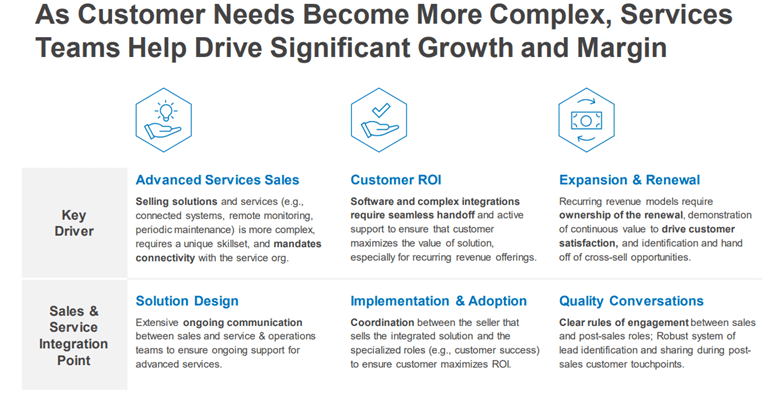New Journeys, New Solutions - Part 3
Realigning Sales, Service and Operations to Serve the Evolving Buyer’s Experience
In part 1 and part 2 of this three-part series, we discussed changes in the buyer journey—as customers’ expectations evolve, so do the sales motions required to support their new path. Leading chemical and specialty materials manufacturers and distributors are shifting to the ILAER sales model: Identify → Land → Adopt → Expand → Renew products. This model reflects that selling is no longer a linear “access, persuade, fulfill” model of order to fulfillment but a circular model that allows sellers to embed their products into the buyer’s operations. Part 3 of this series will explore the investments and strategies needed to implement the ILAER model.
Rethinking the Economic Model
Create the building blocks
Digital offerings, overlay roles and customized buyer journeys are the way forward for manufacturers and distributors. But they do require investment, coordination and partnership to be successful.
The ILAER sales model has proven successful for software sales but is also applicable for manufacturing and distribution. The key to implementing the model is to transition from the linear mindset of “order to fulfillment” to a circular model of continuous adoption, expansion and renewal. It requires manufacturers and distributors to embed not only their products but the products’ value propositions into the buyer’s enterprise. It is the value they derive from related products that make the ILAER model successful.
Tying expansion to adoption
The adoption phase, measured by product usage, is critical to Customer Success. Successful adoption helps the seller embed the value proposition into the buyer’s organization, increasing opportunities for expansion and renewal. Where the Identify and Land motions of the ILAER sales model are initiated by the core seller and supported by service expertise, the AM, CSR and service roles are critical to the Adopt → Expand → Renew circular phase. These roles stay close to the customer throughout the initial adoption phase, providing support that ensures user acceptance while laying the groundwork for expansion opportunities, including upselling and cross-selling.
Upsell success requires proof that the initial adoption phase was productive. Success lies in demonstrating that the product solved an existing customer problem. Providing before and after metrics, testimonials or other evidence is also critical.
Upsell success requires that sellers have a detailed understanding of a buyer’s problem and can tie a specific solution to that problem. Customer success or service roles who maintain close post-sale contact with customers are most likely to spot buyer issues first. However, it is critical for these roles to communicate these opportunities to core sellers, AEs and AMs. Companies who use sales enablement tools, like CRMs, can provide the transparent communications needed for upsell opportunities across all sales-related roles.
In addition to CRMs, companies enable their service organizations with advanced tools to better support customers and the selling function. According to Alexander Group’s latest Manufacturing & Distribution Industry Trends Research, the most commonly used tools in North America include web chat and call center platforms, currently used by over half of organizations. In addition, our research indicates that product usage tracking apps and processes that identify upsell and cross-sell opportunities are used by 26% of companies.
Expansion plays, including upselling and cross-selling, offer use cases as a proof point. Manufacturing and distribution use cases can include existing case studies within the buyer’s industry or newly created use cases that demonstrate a new value proposition. Traditional presentation approaches include offering use cases to lower-level buyers to solve existing problems or to executive buyers to support a longer sales cycle.
Sellers must craft an upsell opportunity as a solution tailored to the buyer’s pain point, being more effective if they offer a unique value proposition with a demonstrated ROI. Upsell options that offer generic or unproven products will typically fail without proof of previous success. Buyers have a B2C mentality and want proof that solutions work before they buy it, making it easier to sell the solution and adopt it within their organization.
AMs, customer success, service and specialist roles are the first to identify buyer problems since they are involved in the day-to-day customer activities. Therefore, training these resources to identify customer issues and offer potential upsell or cross-sell solutions is critical to expansion success.
Balancing sales and coverage
Companies are adding new selling roles and competencies to support the new buyer journey. However, these new roles must be thoughtfully designed and incorporated into the seller’s Revenue Operations strategy to serve customers and meet revenue and margin goals.
Core sellers typically own the customer relationship and have limited bandwidth to address all customers’ needs. Increasing seller turnover accentuates this bandwidth issue as experienced sales professionals leave the profession. Alexander Group’s Manufacturing & Distribution Industry Trends Research shows companies are reporting that over 10% of their sellers will retire in the next two years. Newer sellers want broader career paths yet need advanced technical and business acumen. Core sellers are an expensive and necessary investment but require supporting roles to ensure appropriate sales coverage.
AEs, AMs, customer success and service roles are just a few of the positions being added to the Revenue Operations function, resulting in a complex coverage model with diverse compensation programs. These roles are necessary for customer acquisition and retention and benefit from being lower cost than core sellers. As a result, Alexander Group’s research indicates that overall Compensation Cost of Sales (CCOS) has increased by 15% in the last two years as manufacturers balance sales, support and service roles for each customer.
Manufacturers are using the ILAER strategic sales model to align their resources and maximize their margin. They are deploying sales, operations and service resources to match the type of product, customer and sales cycle integration point, as shown below:

| Identify & Land | Adopt | Expand & Renew | |
| Key Driver | Complex selling solutions that require unique skill sets | Buyer maximizes solution value and ROI, especially for recurring revenue offerings. | Demonstrate continuous value, drive customer satisfaction, identify upsell & cross-sell opportunities |
| Integration points | Extensive, ongoing communications for seamless implementation | Coordination between multiple roles to ensure customer success. | Transparent communications of post-sale touchpoints (CRM & other tools) |
| Roles | Sales, Service, Operations | Sales, Customer Success, Service | Renewal owner, post-sale roles |
The ILAER approach offers more specific skillsets, enhanced buyer adoption, customer retention and sales expansion at a lower cost to the selling organization. Skilled service experts are a core part of this model, bringing problem-solving and technical expertise to the table. As a result, per recent Alexander Group research, manufacturers are investing in training for all resources, increasing their training expense per seller by 30% to decrease ramp-up time by 25%.
Conclusion
As the buyer’s journey for manufacturers and distributors evolves, organizations are implementing new resources that help them attract and retain customers. In addition to digital sales operations, the selling strategy must also evolve from a linear order-fulfillment approach to a circular Identify → Land → Adopt → Expand → Renew (ILAER) approach that embeds the seller’s value proposition into the organization. This approach provides more value to the customer but requires manufacturers and distributors to implement highly coordinated Revenue Operations that includes sales, operations, application knowledge and service expertise. The benefit to manufacturers and distributors is more expansion opportunities that use lower-cost resources while offering greater value to the customer.
Designing a clear sales strategy that aligns with the ILAER approach takes expertise. Alexander Group helps manufacturers and distributors grow revenue while implementing leading operational models to help them remain competitive. Our leading research and benchmarks support our clients in achieving industry-leading high-growth and a sustainable place in the competitive marketplace.
For more information on how Alexander Group can assist you with your commercial strategy, please contact a Manufacturing or Distribution practice lead.




